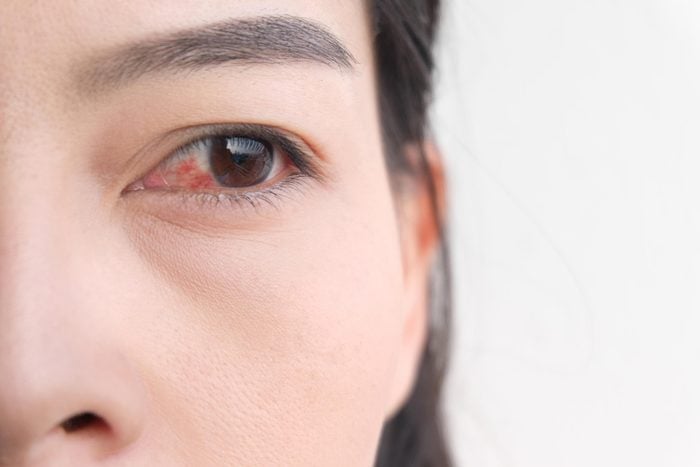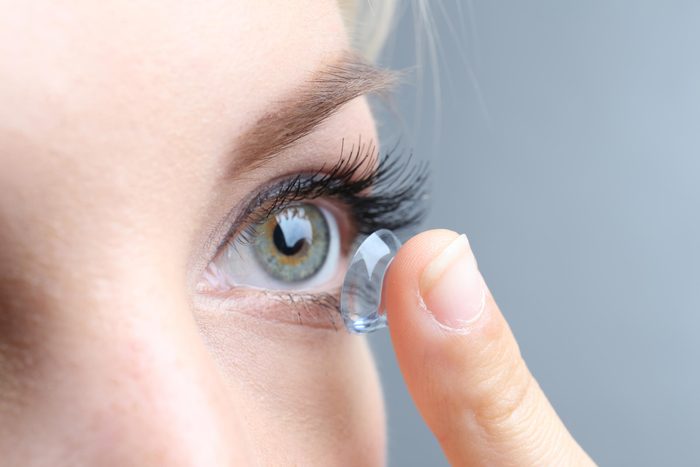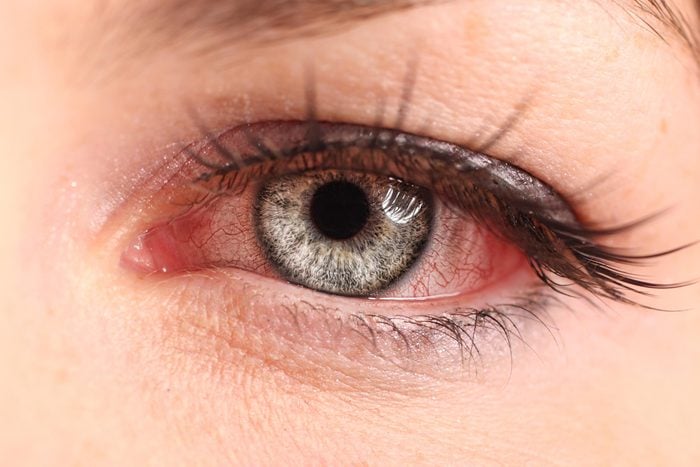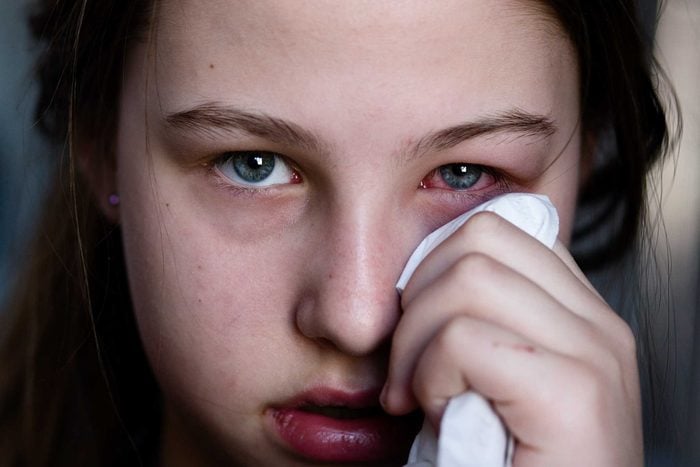
What is pink eye?
Pink eye is what people use to describe a condition called conjunctivitis, which is an inflammation of the conjunctiva. What is the conjunctiva? Well, it’s a thin layer of tissue that covers the white part of the eye and inside of the eyelid that protects and lubricates your eye by producing mucus and tears. When something irritates the eye or disrupts the conjunctiva (such as bacteria or viruses), you’ll have pink eye symptoms including reddening in the whites of the eyes, itching, burning, and extra tear and mucus formation. (Also, find out why you’re getting the wrong pink eye treatment.)

What causes pink eye?
A few causes of pink eye include viruses, bacteria, and allergens. Still, anything from chemicals to contact lens solution could cause pink eye, too. Finding the root cause is tricky since some of the symptoms are the same no matter their cause. Some contagious viruses and bacteria can cause pink eye, but that’s not always the case.
If you have pink eye but no fever or other symptoms, it could be OK to go back to school or work if you have your doctor’s approval, according to the Centers for Disease Control and Prevention. (However, if you will be in close contact with other people, it’s best to stay home until symptoms resolve, they say.)

Pink eye symptom: Your eye is red or pink
As the nickname implies, pink eye often shows up as pinkness or redness in the eye. It’s most commonly caused by a bacterial or viral infection, which is spread similarly to the common cold. But there are other types of conjunctivitis that are not contagious, and they can be the result of allergies (allergic conjunctivitis), exposure to irritants (chemical conjunctivitis), or along with dry eye (secondary conjunctivitis).
“A lot of people think that pink eye is strictly an infection, like a bacterial infection, that they need antibiotics for, but the majority are caused by viruses,” says Michael Hanak, MD, assistant professor of family medicine at Rush University Medical Center in Chicago. (Antibiotics won’t help treat pink eye due to a virus or other cause.)
In cases of allergic conjunctivitis, red eyes may be accompanied by other allergy symptoms such as runny nose and sneezing. If you notice your eye is red or pink in color, it could be a sign of pink eye. Be sure to wash your hands after you touch your eyes so as not to spread the infection (if you have one) and check for other pink eye symptoms.
If the eye redness isn’t spread throughout the entire eye, it could be a subconjunctival hemorrhage. These can appear as one or more red spots on the white part of the eye due to broken blood vessels, according to the American Academy of Ophthalmology (AAO). Although they can look a little scary, subconjunctival hemorrhages are often harmless and typically heal on their own, according to the AAO. (These are the subtle signs of a dangerous eye infection.)

Pink eye symptom: Your eye is leaking fluid
Discharge from the eye can be associated with pink eye, which causes inflammation or infection of the mucous membrane that lines the surface of the eye and the inner surface of the eyelid, according to Kimbra A. Bell, MD, assistant professor of clinical medicine at Northwestern University’s Feinberg School of Medicine in Chicago.
Viral conjunctivitis is typically associated with a clear or white discharge, while bacterial conjunctivitis is typically associated with a yellowish or pus-like discharge. Any unusual discharge from the eye could end up being a symptom of pink eye. If you have viral conjunctivitis, which accounts for the majority of cases of pink eye, you won’t need antibiotic drops—in fact, they won’t help. Instead, alternate between pressing cool and warm compresses to the eye to reduce irritation and inflammation until the condition clears up on its own.

Pink eye symptom: Your eye feels crusty
When you have bacterial conjunctivitis, the body produces pus and mucus to help fight off the bacteria. That mucus can spread like a film over the eye that distorts your vision temporarily. “When you have the eye shut for prolonged periods of time, like overnight, mucus can build up,” explains Dr. Hanak. “As it’s exposed to air along the lining of your eyelid, it dries and almost creates a crust along each of your eyelashes.” In fact, you can wake up in the morning with your eye crusted shut.
Resist the urge to tug at your encrusted lashes because if you accidentally pull them out, you can create space for bacteria to enter and cause additional problems. Instead, use a warm washcloth to soften the crust off your eyelids and gently wipe it away. If you have bacterial conjunctivitis, see your doctor for antibiotic eye drops. (These are the 8 things eye boogers reveal about your health.)

Pink eye symptom: Your eyes are more irritated than usual during allergy season
Sure, rubbing itchy eyes will make them red and irritated. But if you have allergies and are experiencing serious irritation, redness, tearing, or itching in your eyes, it could be a sign of allergic conjunctivitis, which is not infectious or contagious and can be treated using allergy eye drops or oral allergy medications.
“Allergic conjunctivitis does not typically present with discharge as the infectious conjunctivitis does, but more so with irritation, itching, and redness,” Dr. Bell says. (Find out if your itchy eyes are really a sign of eyelid dermatitis.)

Pink eye symptom: You have a cold and it’s affecting your eyes
If you’ve just come down with a seasonal bug and now your eyes are irritated, it could be one of the more annoying pink eye symptoms.
“If you were coughing yesterday and then you touched your face or your eyes, you could have unintentionally spread the same pathogen that causes pink eye,” Dr. Hanak says.

Pink eye symptom: Your eyes are really dry
Dry eye is a fairly common condition, but it’s also possible to get conjunctivitis secondary to dry eye after being exposed to the elements, including high wind and direct sun. It can also happen to people who lack sufficient tear production. Dry eye is caused by a lack of lubrication and it makes your eyes feel itchy and irritated.
“As a result of the dryness, the eye can get it can inflamed and irritated and become red,” says Dr. Bell. “Treatment is just a matter of extracting yourself from what the precipitating factor was.”

Pink eye symptom: You’ve been exposed to toxic air
Chemicals, fumes, or smoke getting into the eye can cause irritant conjunctivitis, a non-contagious form of the condition. Obviously try to avoid the source of the irritant, which should resolve this form of pink eye.
In the meantime, Dr. Bell recommends using warm or cold compresses on the eye to manage symptoms. This type of pink eye clears up quickly and in some cases resolves in as little as 48 hours. Viral and bacterial conjunctivitis usually takes up to 7 to 10 days to clear. (Don’t miss these other eye health secrets doctors won’t tell you.)